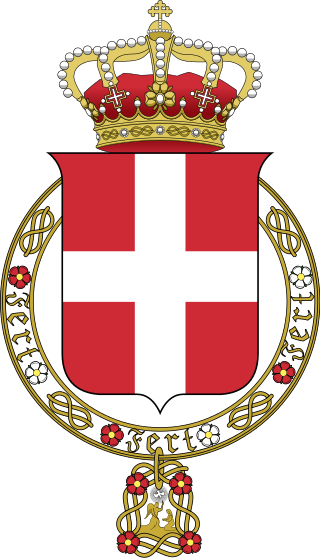
The House of Savoy is an Italian royal house that was established in 1003 in the historical Savoy region. Through gradual expansion, the family grew in power from ruling a small Alpine county northwest of Italy to absolute rule of the Kingdom of Sicily from 1713 to 1720, when they were handed the island of Sardinia, over which they would exercise direct rule from then onward.

The Teatro Regio is a prominent opera house and opera company in Turin, Piedmont, Italy. Its season runs from October to June with the presentation of eight or nine operas given from five to twelve performances of each.

The Palazzina di caccia of Stupinigi is one of the Residences of the Royal House of Savoy in the Metropolitan City of Turin in northern Italy, part of the UNESCO World Heritage Sites list. Built as a royal hunting lodge in the early 18th century, it is located in Stupinigi, a suburb of the town of Nichelino, 10 km (6 mi) southwest of Turin.
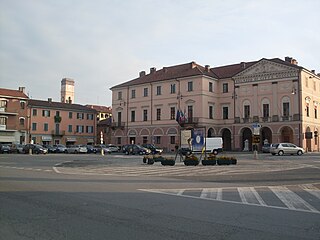
Racconigi is a town and comune (municipality) in Piedmont, Italy. It is located in the province of Cuneo, 40 kilometres (25 mi) south of Turin, and 50 kilometres (31 mi) north of Cuneo by rail.

The Residences of the Royal House of Savoy are a group of buildings in Turin and the Metropolitan City of Turin, in Piedmont. It was added to the UNESCO World Heritage Sites list in 1997.

Palazzo Madama e Casaforte degli Acaja is a palace in Turin, Piedmont. It was the first Senate of the Kingdom of Italy, and takes its traditional name from the embellishments it received under two queens (madama) of the House of Savoy.
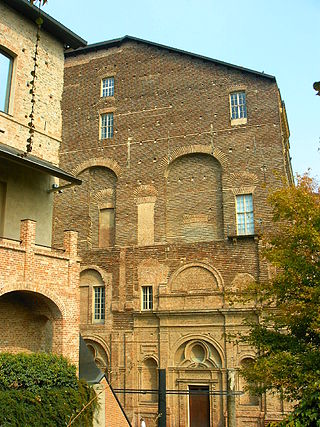
The Rivoli Castle is a former Residence of the Royal House of Savoy in Rivoli. It is currently home to the Castello di Rivoli – Museo d'Arte Contemporanea, the museum of contemporary art of Turin.

The Valentino Castle is a historic building in the northwestern Italian city of Turin. It is located in Parco del Valentino, and is the seat of the Architecture Faculty of the Polytechnic University of Turin. It is one of the Residences of the Royal House of Savoy included in the list of UNESCO World Heritage Sites in 1997.

The Castle of Moncalieri is a palace in Moncalieri, Piedmont, in northern Italy. It is one of the Residences of the Royal House of Savoy listed by UNESCO as World Heritage Sites in 1997.
Stupinigi is a frazione (hamlet/borough) of the comune (municipality) of Nichelino, in the Metropolitan City of Turin. It has a population of about 200. It borders the comuni of Candiolo and Orbassano on the southwestern outskirts of Turin, about 10 km from the centre of the city. Before 1869, it formed part of the comune of Vinovo.

The Basilica of Superga is a hilltop Catholic basilica in Superga, in the vicinity of Turin, Italy.

The Royal Palace of Turin is a historic palace of the House of Savoy in the city of Turin in Northern Italy. It was originally built in the 16th century and was later modernized by Christine Marie of France (1606–1663) in the 17th century, with designs by the Baroque architect Filippo Juvarra. The palace also includes the Palazzo Chiablese and the Chapel of the Holy Shroud, the latter of which was built to house the famous Shroud of Turin.

French Renaissance architecture is a style which was prominent between the late 15th and early 17th centuries in the Kingdom of France. It succeeded French Gothic architecture. The style was originally imported from Italy after the Hundred Years' War by the French kings Charles VII, Louis XI, Charles VIII, Louis XII and François I. Several notable royal châteaux in this style were built in the Loire Valley, notably the Château de Montsoreau, the Château de Langeais, the Château d'Amboise, the Château de Blois, the Château de Gaillon and the Château de Chambord, as well as, closer to Paris, the Château de Fontainebleau.

Palazzo Carignano is a historical building in the centre of Turin, Italy, which houses the Museum of the Risorgimento. It was a private residence of the Princes of Carignano, after whom it is named. Its rounded façade is different from other façades of the same structure. It is located on the Via Accademia delle Scienze.

The Palace of Venaria is a former royal residence and gardens located in Venaria Reale, near the city of Turin in the Piedmont region in northern Italy. It is one of the 14 Residences of the Royal House of Savoy built in the area between the 16th and 18th centuries which were collectively designated a UNESCO World Heritage Site in 1997.

Turin is a city and an important business and cultural centre in Northern Italy. It is the capital city of Piedmont and of the Metropolitan City of Turin, and was the first Italian capital from 1861 to 1865. The city is mainly on the western bank of the Po River, below its Susa Valley, and is surrounded by the western Alpine arch and Superga hill. The population of the city proper is 843,514, while the population of the urban area is estimated by Eurostat to be 1.7 million inhabitants. The Turin metropolitan area is estimated by the OECD to have a population of 2.2 million.

The Villa della Regina is a palace in the city of Turin, Piedmont, Italy. It was originally built by the House of Savoy in the 17th century.

Emmanuel Philibert of Savoy, 2nd Prince of Carignano, Prince of Carignano, was the son and heir of Thomas Francis, Prince of Carignano. He constructed the Palazzo Carignano in Turin.
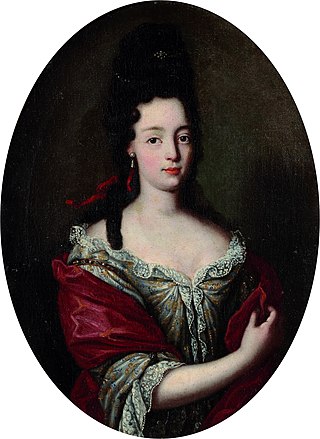
Maria Angela Caterina d'Este was an Italian-born Princess of Modena who was later the Princess of Carignano by marriage. She was the wife of Emmanuel Philibert of Savoy, Prince of Carignano. In France she was known as Angélique Catherine d'Este and in Modena and Savoy she was known as Maria Caterina d'Este.
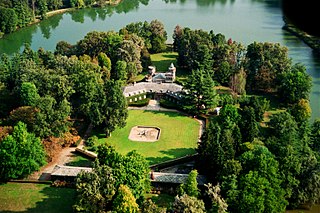
La Mandria Regional Park is a park in the comuni of Venaria Reale and Druento, near Turin, northern Italy. Founded in 1978 by the regional council of Piedmont, it occupies a wide area between the Stura di Lanzo torrent and the north-western part of Turin and Venaria.





















